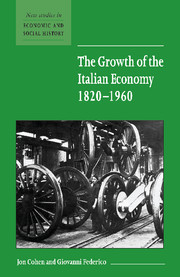Book contents
- Frontmatter
- Contents
- List of figures
- List of tables
- Acknowledgements
- 1 Introduction
- 2 Measuring change in the long run: the data
- 3 The big picture: models of growth and structural change
- 4 Modernization versus tradition: new views and old on agriculture
- 5 Against all odds? The growth of industry and services
- 6 Macroeconomic policy, institutions, and the balance of payments
- 7 An economic miracle? Italy in the Golden Age, 1945–1960
- 8 Conclusion
- Bibliography
- Index
- New Studies in Economic and Social History
- Previously published as Studies in Economic and Social History
- Economic History Society
6 - Macroeconomic policy, institutions, and the balance of payments
Published online by Cambridge University Press: 05 June 2012
- Frontmatter
- Contents
- List of figures
- List of tables
- Acknowledgements
- 1 Introduction
- 2 Measuring change in the long run: the data
- 3 The big picture: models of growth and structural change
- 4 Modernization versus tradition: new views and old on agriculture
- 5 Against all odds? The growth of industry and services
- 6 Macroeconomic policy, institutions, and the balance of payments
- 7 An economic miracle? Italy in the Golden Age, 1945–1960
- 8 Conclusion
- Bibliography
- Index
- New Studies in Economic and Social History
- Previously published as Studies in Economic and Social History
- Economic History Society
Summary
6.1 The unification of Italy in 1861 caught almost everyone, both in Italy and abroad, by surprise. The task ahead, summed up by the famous observation, ‘Italy is made, now it is necessary to make the Italians’ (D'Azeglio), was immense. The states of the peninsula, many independent since the collapse of the Roman empire, had to be integrated into a single entity with a unified civil service, a consistent legal framework and a single currency. The country's social overhead capital, inadequate and unevenly distributed, was in dire need of attention. There were, for example, only 2,404 km of railway lines, the nineteenth-century measure of modernity, in the entire country - i.e. 0.096 km per inhabitant - vs. 0.251 in France, 0.295 in Germany and 0.734 in the United Kingdom (Schram 1997, tables 2 and 3). About 40 per cent were in Piedmont, while the South as a whole had less than 10 per cent. The patrimony of roads, ports and other public facilities was equally unimpressive and skewed regionally.
In spite of the challenges, the overall mood was sanguine. Italy, many believed, had been mismanaged. With freedom, unity and sound economic policies, the new nation would thrive and would at least be able to narrow, if not close, the gap between it and the more advanced countries of Europe. The Italian ruling class - a small elite of (mostly) landowners – set to the task with great energy and enthusiasm.
- Type
- Chapter
- Information
- The Growth of the Italian Economy, 1820–1960 , pp. 70 - 86Publisher: Cambridge University PressPrint publication year: 2001



